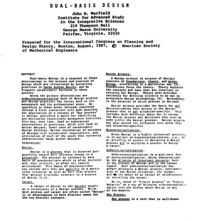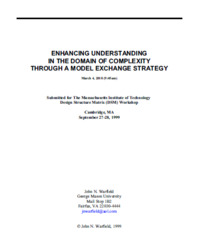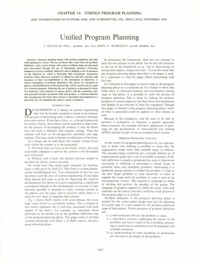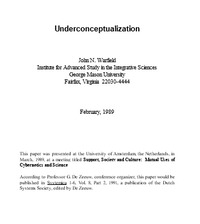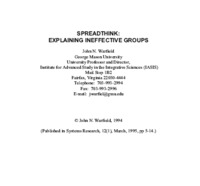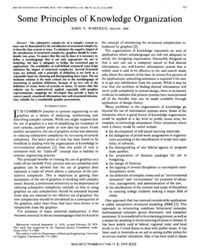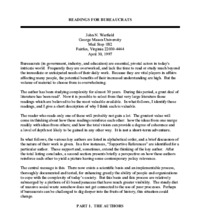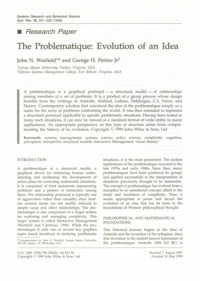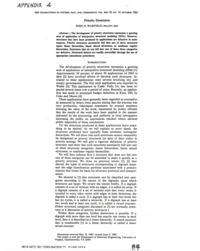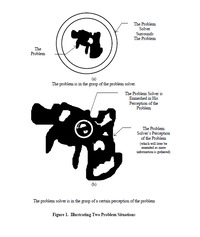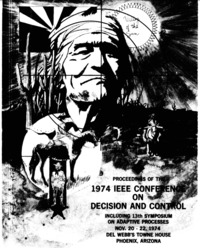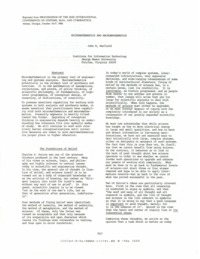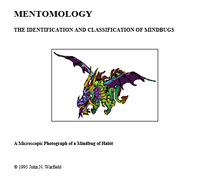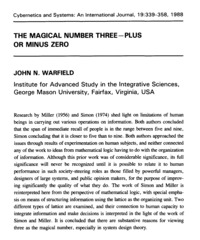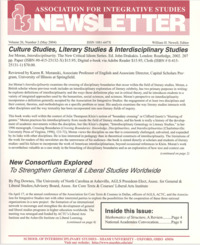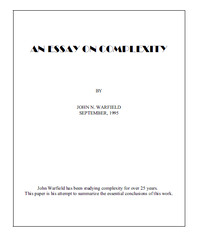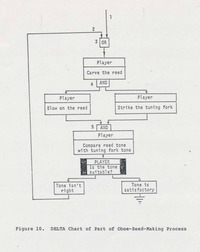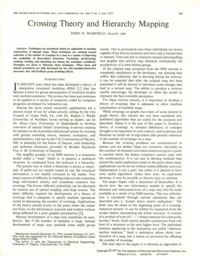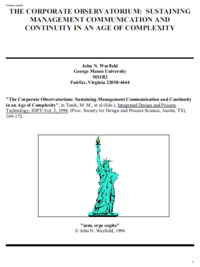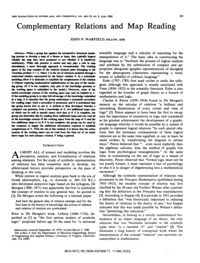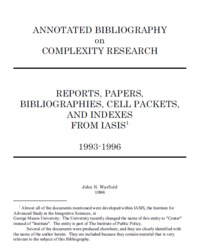Guided Tour
Soon you will be able to browse a full catalog of Dr. Warfield's work, which includes over 2,000 entries including books, videos, presentations and published and unpublished papers. Many will be available for free download.
For now, we offer a "Guided Tour" on this page of Dr. Warfield's most important works:
Likely part of an intended book manuscript. Discusses Warfield’s economic research and the ways in which Interpretive Structural Modeling could assist international organizations operate more effectively. See also, “Principal Subsystems (Dimensions) and Legacy Organizational Structures.”
Multiple documents are associated with this number. Collection of materials for paper Warfield planned to write to discuss the next stage beyond Interactive Management, a stage of management which he had termed Work Program of Complexity Includes a comparison between Interactive Management and the Work Program of Complexity, an outline of Warfield’s 3 February 2004 Presentation “The Work Program of Complexity,” and a description of 14 tangible and 5 intangible results a corporation could expect from using Warfield’s Work Program of Complexity when trying to manage a difficult situation.
Dual-Basis Design - 1987
Discussion of the concept of due process in design as a way to identify and monitor responsible management practices, which would lower the rate of catastrophic design failures. Warfield calls for the creation of a basic design science, with standards and practices for large-scale system designers that could become well-defined and legally enforceable over time. Prepared for ASME Conference, Boston, MA, 17-20 August 1987. See, "Dual-Basis Design (Transparencies)" for the transparencies developed to accompany talk. Later printed in Polish. See, "Dwie Podstawy Projektowania (Dual-Basis Design)."
Discussion of a model exchange strategy in the domain of complexity. The abstract states that the “overall effectiveness must take into account factors that are not well-treated exclusively by matrix models. Some of the other types that (also) have limited, but valuable, utility include: algebraic models, prose models, various ill-defined graphical models (often understood only by very small practitioner sets), and prose-graphic structural models.” Originally presented 28 September 1999 at the MIT Design Structure Matrix (DSM) Workshop, Presentation, Sloan School, Cambridge, MA. See also,"MIT Design Structure Matrix Workshop Program"
This paper illustrates how self-interaction and cross interaction matrices can be used to portray interactions among several sets that can be important in program planning. It is a precursor to the development of interpretive structural modeling, in that the unwieldiness of the matrices, the need for directionality in relations, the need for computer assistance in keeping track of the information, and the need for a more easily read graphical portrayal all became apparent in working with the various planning matrices.
This paper addresses a need for change in how people work with complexity. The needed change is described as "Framebreaking and Remodeling." The term "Underconceptualization" is used to capture the essence of what is wrong in design, development and operation of large-scale systems. Presented at Conference on Mutual Uses of Cybernetics & Science, University of Amsterdam, 27-31 March 1989. This conference paper submitted in 1989 is free of typo errors seen in 1991 published article.
Warfield’s data on individual reactions to group problems has revealed a phenomenon he calls Spreadthink, e.g, there exists a consistent lack of commonality of viewpoint, no matter what the group, no matter what the problem. The disparity in attitudes among individuals is so great as to produce ineffective group decision making unless further education and understanding takes place between group members. Presented at 16th Annual Meeting, Assn. for Integrative Studies, Duquesne University, Pittsburgh, PA, 30 September 1994.
Contains part of the theory needed for writing Interpretive Structural Modeling software. The mathematical theory of how to eliminate overlap among concepts, using Translatable Graphics, Structural Types, Problem Definitions, Block Representation of Sets, and Mapping Theory, can be helpful in replacing a set of overlapping goals with a set of relatively independent goals when constructing a usable planning or policy decision.
Readings for Bureaucrats - 1997
This is a bibliography, a short, fully annotated list of works by 33 authors whose writings contribute to essential knowledge needed to understand and take advantage of the Warfield program for dealing with complexity. This paper was used as a handout to accompany a talk Warfield gave to the AAAS Fellows meeting (American Association for the Advancement of Science) in Washington, D.C. on 13 May 1997.
This is a greatly reduced and greatly altered version of a paper by the same title which John Warfield wrote in 1996 and submitted to Systems Research in 1997. It is a review of the intellectual history presaging the development of the Interactive Management (IM) adaptation and use of structural graphics to display results of IM Workshops.
Priority Structures - 1980
This paper comprises part of the theory needed for writing ISM software, giving techniques for correcting structural defects (e.g. non-regular hierarchical structures) when using Interpretive Structural Modeling. The paper was included as part Warfield's GRAILS proposal (ADA Syntax Study and Recommendations: A Proposal to the Software Productivity Consortium, Part 1, A Graphically-Integrated Language System: A Proposal to the Software Consortium, Part 2), as an appendix.
The cascading weight of transitivity is made clear using layman’s terms. Explains the need for publicly viewed structural models and discusses use of, and need for, problematiques. Used as a classroom handout at the Defense Systems Management College where Warfield conducted a series of Interactive Management workshops and lectures for the teaching staff.
Considered by Warfield to be one of his most important papers, this is a description of the seven Interactive Management processes developed at the Center for Interactive Management at the University of Virginia in Charlottesville. It deals with an approach to how humans might be able to tackle and solve the "gigantic mess" problems of society which are currently beyond human endeavor and often beyond human intellectual grasp. This was the Society for General Systems Research (SGSR) Presidential Address, presented at 27th Annual Meeting SGSR, Book-Cadillac Hotel, Detroit, Michigan on 26 May 1983.
To view the full copyrighted abstract written in the authors' own words please use http://ieeexplore.ieee.org/document/4045316/?reload=true&arnumber=4045316%2F#document-tabs.
Building on Charles S. Peirce's ideas on symbolic logic and the organization of human knowledge, this is a presentation of a model of information-gathering and processing which will reliably and incrementally increase humanity's storehouse of accurate, usable scientific knowledge. In part, this paper is a protest against current enshrinement of the superficial and insufficient 'artificial intelligence', (a widely utilized methodology which is said to be superficial and insufficient to human needs). Includes discussion of the “Cosmic Partition,” which he introduced at the 1985 SGSR Annual meeting in Los Angeles in his paper "On the Choice of Frames for Systems Studies."
A satirical attack on fuzzy or faddish thinking. This manuscript originated as an Email contribution to the Learning Organization List-serve.
The work of George Miller and H. A. Simon is reinterpreted from the perspective of mathematical logic, showing substantive reason for the conclusion that three is the 'magical number,' especially in system design theory. For the transparencies to accompany this lecture, see "The Magical Number Three--Plus or Minus Zero (transparencies)." Presented at the International Conference of Society for General Systems Research, 1-6 June 1987, Budapest, Hungary.
Paul Bugl, a professor of Mathematics at University of Hartford wrote this informative and positive review of Warfield's book The Mathematics of Structure (Palm Harbor, FL: AJAR, 2002).
An Essay on Complexity - 1995
A broad summary of Warfield’s “essential conclusions” he has reached during his research on complexity. Provides definition, description, ways of measuring and suggestions for reducing complexity. Is similar to his seminar talk “The Great University.”
ABSTRACT: A mathematical basis is presented for possible use in evaluating more accurately the various elements which must be considered in group decision-making. The term, "dimensionality" is given a new meaning describing the limits of inter-relationship between the elements. The triangular "quad" figure is introduced as a method of graphic portrayal of hierarchically related element. Presented at IEEE International Conference on Systems, Man & Cybernetics, 14-17 October 1986, Atlanta, Georgia. See also, “Dimensionality.”
States that managers, when confronted with large complex problems (problem situations), must beware that assuming ideas and using methods which work for simpler problems can become a disaster when applied to those problem situations with complex origins, multiple root causes and unquestionably difficult solutions. See also, “Stalking the Killer Assumptions.” Presentation given 1 October 1998 at the Institute of Public Policy (TIPP) Colloquium, George Mason University.
A description of a new kind of flow-chart, designed to incorporate not only events and activities but also decision and logic functions. DELTA charts can display a number of different options, as well as `loops' in project plans, at the research and development stage. Slightly modified version of this paper later published in Battelle Monograph No. 1 “A Unified Systems Engineering Concept.”
Paper contains parts of the theory needed for writing ISM software. Techniques are introduced which are applicable to machine construction of digraph maps. To view the full copyrighted Abstract written in Warfield's own words please use the DOI link given above.
Suggests that the public can learn any sort of complex idea if it is properly illustrated visually, and that Interactive Management's structural models are the best tool for such illustrations. Calls for buildings similar to modern art galleries, with wall displays of ideas rather than pictures. Presented at 2nd World Conf. Integrated Design & Process Technology, Marriott Hotel, Austin, Texas, 1-4 December 1996. See also, The Corporate Observatorium (Abstract).
Contains part of the theory needed for writing ISM software. A description of a method for computer-assisted interpretation of graphical structural models, without requiring mathematical sophistication on the part of the working group using the model. To view the full copyrighted Abstract written in Warfield's own words please use the DOI link given above.
Provides titles, authors and detailed abstracts of complexity related writings. Arranged by format, with the categories: Reports, Papers, Bibliographies, Cell Packets and Indexes. Supersedes similar biographies issued in 1994 and 1995.



